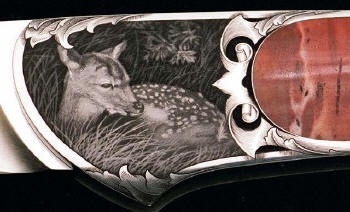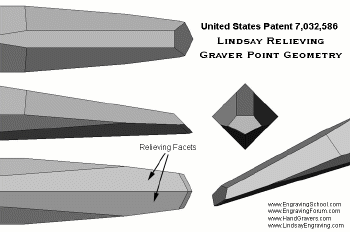|
The Art of Engraving
In order to create quality detailed engravings, the engraver is required to accurately execute many
cuts or lines in the metal that vary in length, width, and depth. In principle, the results achieved are similar to those produced by an artist when sketching with
pen or pencil on paper. Spectacular ornamental engravings are possible when the graver is controlled by someone who is well versed in the art of engraving.
Use of
advanced methods, such as 'Bulino' and 'Bank note' techniques, allow the
highly skilled artist, the potential to produce exquisite, lifelike
renderings in metal.
 'Bulino'
(pronounced - 'bo-lee-no') - refers to a Pointillism or Dot Technique. It
is derived from the Italian term meaning "a small hand held graver". Today
the term is used loosely to represent the method of creating thousands of
small dots or lines in the metal. This enables the control of light and
dark contrasts. 'Bulino'
(pronounced - 'bo-lee-no') - refers to a Pointillism or Dot Technique. It
is derived from the Italian term meaning "a small hand held graver". Today
the term is used loosely to represent the method of creating thousands of
small dots or lines in the metal. This enables the control of light and
dark contrasts.
'Bank note
style' is a highly organized and systematic method of creating thousands
of individual lines, varying in length, in order to form beautifully
detailed renderings or ornamental designs. It is generally seen on pages
of older texts such as, family Bibles and similar period works of
literature printed from engraved plates. The closest and most common
representation of this technique in the present may be seen on paper
currency.
An artist's
ability to visualize where and how each cut should be placed determines
the final outcome of the project. When an engraving artist possesses a
talent for visualization, as well as theoretical and technical knowledge,
he or she will be able to invest the engraving with richness, character,
and even emotion.
 Tool
geometry and the manner in which the
graver is shaped, particularly the face and heel angles, will also
determine the quality of an engraving. The ability to perfectly grind and
shape the graver must be mastered, otherwise clean, accurate, burr-free
cutting will not occur, and the results will be unsatisfactory. Badly
raised burrs tend to produce visually jagged or distorted lines, resulting
in a rough, unrefined final product, rather than the smooth, clean results
professionals can produce. If the engraver applies too much downward force
while cutting, or the graver heel is too long or too short, burrs will be
raised - especially when executing curved lines. A long heel will create
drag, and a short heel will dig too deeply into the metal. Either way, the
metal will be forced upwards, generating a burr along the length of the
cut. Tool
geometry and the manner in which the
graver is shaped, particularly the face and heel angles, will also
determine the quality of an engraving. The ability to perfectly grind and
shape the graver must be mastered, otherwise clean, accurate, burr-free
cutting will not occur, and the results will be unsatisfactory. Badly
raised burrs tend to produce visually jagged or distorted lines, resulting
in a rough, unrefined final product, rather than the smooth, clean results
professionals can produce. If the engraver applies too much downward force
while cutting, or the graver heel is too long or too short, burrs will be
raised - especially when executing curved lines. A long heel will create
drag, and a short heel will dig too deeply into the metal. Either way, the
metal will be forced upwards, generating a burr along the length of the
cut.
 It
can take years to fully master the technical portion of hand engraving,
and to become proficient in design and in the historical study of
engraving motifs. Only then can one begin to develop a unique and personal
artistic style. However, some students of this art may possess a natural
talent, which allows them to master the process more rapidly. It
can take years to fully master the technical portion of hand engraving,
and to become proficient in design and in the historical study of
engraving motifs. Only then can one begin to develop a unique and personal
artistic style. However, some students of this art may possess a natural
talent, which allows them to master the process more rapidly.
Mastering the
Art of Engraving requires expertise in several areas. These can be divided
into two categories: art and craft. Engravers engaging only in craft need
not possess drawing and design skills to produce excellent engravings,
providing that designs are supplied beforehand by either an artist or by
replication of available ornamental patterns. Many copyright-free (public
domain) ornamental designs are available to help the craftsman in this
area. The first and foremost ability a craftsman need possess, then, is
the ability to precisely control the graver, with an understanding of the
technical skills required in order to achieve the desired results.
However, in
the case of engraver as an artist, he or she must have an intense desire
to create beautiful original designs, which depends upon a background in
other arts, together with artistic drawing talents. The art of engraving
itself can be a fulfilling medium for an artist to express his art, and
can become a life-long study.
------Continue to "The
Engraving Process"--->
|